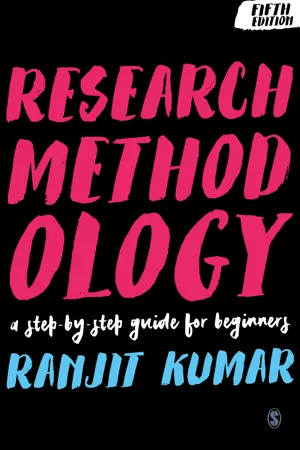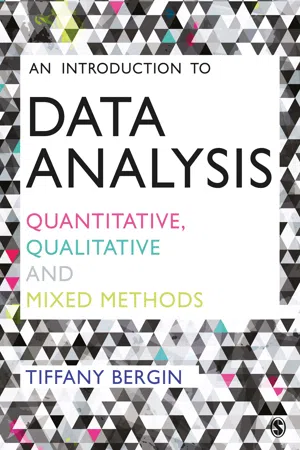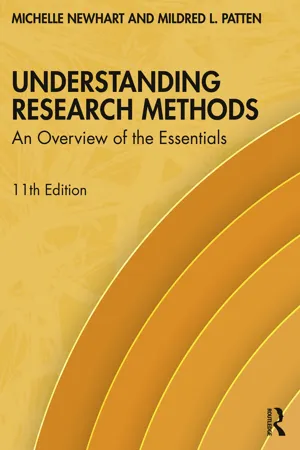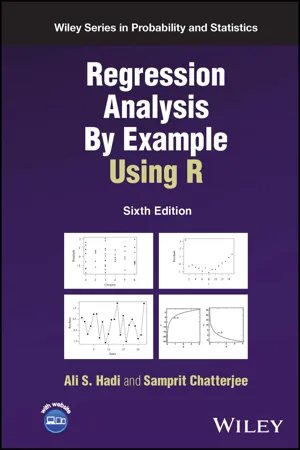Mathematics
Quantitative Variables
Quantitative variables are numerical in nature and represent measurable quantities. They can take on a range of values and are often used in mathematical calculations and statistical analysis. Examples of quantitative variables include age, weight, height, and temperature.
Written by Perlego with AI-assistance
Related key terms
Related key terms
1 of 4
Related key terms
1 of 3
8 Key excerpts on "Quantitative Variables"
- eBook - ePub
School-based Research
A Guide for Education Students
- Elaine Wilson, Elaine Wilson(Authors)
- 2017(Publication Date)
- SAGE Publications Ltd(Publisher)
A quantitative approach usually means measuring a property of something or someone. That property is called a ‘variable’. Variables are called variables because they are entities that can vary. You can collect quantitative data about individuals by designing questionnaires or tests. Alternatively, you can simply record data by observing the subjects ‘from afar’; it all depends on the data you want. However, do bear in mind that the act of collecting data can sometimes change the data you get! Some examples of variables include:- The number of students ‘on roll’.
- The test result.
- The proportion of students gaining five GCSEs at A–C.
- The tier (e.g. primary, secondary, etc.).
- The school governance system.
Variables described using numbers are quantitative (e.g. the proportion of students gaining five GCSEs at A–C). Those described by categories are qualitative or categorical (e.g. the school governance system – foundation, voluntary-aided and so on). Although this chapter is about a quantitative approach, we usually look at qualitative variables as well.Quantitative Variables fall into two types:- Continuous variables can take any value in a given range (e.g. 3.2, 4.798).
- Discrete variables have clear steps between their possible values (e.g. you cannot get 100.324 pupils at a school!).
Another way to think about variables is the scale or level of measurement that we use. The scale itself determines whether they will be qualitative/quantitative or continuous/discrete:- Nominal scales: Are for qualitative variables to categorize observations. The value assigned to a group is just a label, and implies nothing about quantity. Gender would be a variable measured with a nominal scale: we could use ‘1’ for boys and ‘2’ for girls.
- Ordinal scales
- eBook - ePub
- Patricia Barnes-Svarney, Thomas E Svarney(Authors)
- 2012(Publication Date)
- Visible Ink Press(Publisher)
How do television ratings work? Most people associate such ratings with Neilsen Media Research, a group that measures the number of people watching television shows, making that data available to television and cable companies, marketing people, and the media. Overall, like political polling, they use statistical sampling to rate a show. To determine who is watching what shows, they have around 5,000 households that have agreed to be part of a representative sample— a group that is thought to represent the close to 100 million viewers in the United States. The data are collected from installed meters in the households; from there, each member of the household turns a button on and off to show when he or she begins and ends viewing. The data are collected each night and statistically analyzed to determine just what “everyone in America” is watching—or not watching—on television. This one statistical rating determines not only the placement of commercials, but can make or break a program. Such a small sampling of people is also why favorite viewer programs sometimes get cancelled.Qualitative variables are measured on a nominal scale, or a measurement that has assigned items to groups or categories. With these variables, there is no quantitative information and no ordering of the items is conveyed—it is qualitative rather than quantitative. Religious preference, race, and gender are all examples of nominal scales.What other variables are often used in statistics?When an experiment is conducted, variables manipulated by the experimenter are called independent variables (also independent factors), while others measured from the subjects are called dependent variables (also dependent measures). For example, consider a hypothetical experiment on the effect of lack of sleep on reaction time: Subjects either stayed awake, slept for 2 hours for every 24, 5 hours for every 24, or 8 hours for every 24; they then had their reaction times tested. The independent variables would be the hours slept by each person and the dependent variables would be the reaction time.Some variables can be measured on a continuous scale—a continuous variable being one that, within the limits the variable ranges, can take on any value possible. For example, we can make the time to eat a lunch at a certain restaurant be the continuous variable because it can take any number of minutes or hours to finish the meal. But other variables can only take on a limited number of values—or dependent variables. For example, if the variables were a test score from 1 to 10, then only those 10 possible values would be allowed; these are called discrete variables.What are the measures of central tendency?The measures of central tendency are statistics that describe the grouping of values in a data set around a common value that in some way represents a typical member. They are broken down into four types: median, mode, average (also called the arithmetic mean), and the geometric mean. - eBook - ePub
- David Byrne(Author)
- 2002(Publication Date)
- SAGE Publications Ltd(Publisher)
When we speak of a class we are thinking of a very loosely defined body of people who share the same categories of interests, social experiences, traditions and value-system, who have a disposition to behave as a class, to define themselves in their actions an in their consciousness in relation to other groups of people in class ways. But class itself is not a thing, it is a happening. (Thompson, 1978: 85; original emphasis) Death to the variable In quantitative social science the things which we measure are usually called variables. This use of variable as a noun is a modern product of the mathematical representation of the world through scientific modelling. The Oxford English Dictionary defines a variable in maths and physics as: A quantity or force, which, throughout a mathematical calculation or investigation, is assumed to vary or be capable of varying in value. The OED dates the first use to the early nineteenth century. This specifically scientific usage seems to predate the more general application of the idea to describe anything that can vary. It is worth unpacking the OED definition because it actually contains two very different conceptions of the nature of ‘variable’ and two different conceptions of the processes in which variables occur. The idea of variable as quantity simply implies that a measurement can and has been made. The idea of variable as force implies that something real exists and can be measured. The process of mathematical calculation is abstract. The process of investigation involves empirical engagement with the world. The Encyclopaedia of Statistical Sciences (1999) describes variables as ‘features’, although it does not say of what variables are features. It then distinguishes between ‘hidden’ or ‘latent’ variables on the one hand and ‘observed’ or ‘manifest’ on the other - eBook - ePub
Research Methodology
A Step-by-Step Guide for Beginners
- Ranjit Kumar(Author)
- 2018(Publication Date)
- SAGE Publications Ltd(Publisher)
Table 5.2 shows some examples that will help you to understand the process of converting concepts into variables. Note that in these examples only some of the indicators have been picked up. Also, the values set for decision levels are arbitrary and have no empirical validity.One of the main differences between quantitative and qualitative research studies is in the area of variables. In qualitative research, as it usually involves studying perceptions, beliefs or feelings, you do not make any attempt to establish uniformity in them across respondents and hence measurements and variables do not carry much significance. On the other hand, in quantitative studies, as the emphasis is on exploring commonalities in the study population, measurements and variables play an important role.CheckpointDefining variablesTypes of variable
A variable can be classified in a number of ways. The classification developed here results from looking at variables in three different ways (see Figure 5.1 ):- the causal relationship;
- the study design;
- the unit of measurement.
From the viewpoint of causal relationship
In studies that attempt to investigate a causal relationship or association, four sets of variables may operate (see Figure 5.2 ):- variables that are responsible for bringing about change in a phenomenon, situation or circumstance;
- outcome variables, which are the effects, impacts or consequences of a change variable;
- variables which affect or influence the link between cause-and-effect variables; and
- connecting or linking variables, which in certain situations are necessary to complete the relationship between cause-and-effect variables.
In research terminology, change variables are called independent variables, outcome/effect variables are called dependent variables, the unmeasured variables affecting the cause-and-effect relationship are called extraneous variables, and the variables that link a cause-and-effect relationship are called intervening variables - eBook - ePub
An Introduction to Data Analysis
Quantitative, Qualitative and Mixed Methods
- Tiffany Bergin(Author)
- 2018(Publication Date)
- SAGE Publications Ltd(Publisher)
Visit at least one of the databases described above and spend some time investigating the datasets that are available there. Do any of these datasets interest you? Could you use any of these datasets in a future thesis or paper?4.6 What Is a Variable?
We have already come across the term variable several times in this book. You may already have some understanding of what a variable is. However, given the fundamental role of variables in quantitative data analysis – indeed, such analysis often involves the use of statistical methods to measure variables or quantify relationships between variables – it is important to step back and consider exactly what a variable is in more detail.Put simply, a variable is any measurable characteristic, concept, cause, or set of items that you want to investigate through rigorous analysis. Examples of variables include age, temperature, height, or nationality. In our data analyses, we will encounter two main types of variables: dependent variables and independent variables. A dependent variable (which is also often called an outcome variable), is a variable representing the outcome you are interested in. It is the variable whose values you are attempting to predict or explain in your data analysis. An independent variable (known also as a predictor variable), is a variable that you believe might impact or predict the dependent variable that you’re interested in. In Chapter 1 you considered the question of whether temperature affects crime rates. In that example, temperature would be the independent variable and the crime rate would be the dependent variable.In order to include a variable in your data analysis, you must first operationalize the concept or phenomenon you are interested in. This process of operationalization involves turning the object or characteristic of interest into something that can be accurately measured and feasibly included in a data analysis as a variable. For example, we might operationalize the concept of ‘temperature’ as ‘average daily temperature in degrees Celsius’. In a quantitative data analysis, you will typically operationalize your variables using numeric values (or categories that can be converted to numeric values), so that you can include those variables in statistical tests. (Interestingly, as we will see in Chapter 6 - eBook - ePub
Understanding Research Methods
An Overview of the Essentials
- Michelle Newhart, Mildred L. Patten(Authors)
- 2023(Publication Date)
- Routledge(Publisher)
Part 2 delve into the importance of creating variables from concepts in quantitative research. They discuss what variables are and how they are used in developing quantitative research questions and designs, with special consideration for variables in experiments and for measures used in specific circumstances of measurement. The final topics address the research hypothesis and how to write one. In quantitative research, the research hypothesis places the variables together in a set of specific, formalized logical statements.Part 3 Key Terms
Terms appear in bold where they are defined in the text. This list follows the order in which terms are introduced and discussed in Part 3 Topics.concept dependent/criterion/outcome variable intelligence test variable control variable achievement test constant confounding variable aptitude test operationalized/operational definition Hawthorne effect norm-referenced test measure/instrument John Henry effect criterion-referenced test categorical variable placebo effect research hypothesis nominal variable blind/double-blind study null hypothesis ordinal variable demand characteristics alternative hypothesis continuous variable Likert scale directional hypothesis interval/scaled variable reverse scoring non-directional hypothesis ratio variable performance measure research purpose independent/predictor/causal variable Passage contains an image
3 .01Concepts and VariablesDOI: 10.4324/9781003092049-23Studying people for academic research often begins with a conceptual curiosity or question about real-world phenomena. We want to learn about such things as student success, stigma and stereotyping, depression, poverty, happiness, parental support, consumer behavior, and health, as well as the success or shortcomings of programs created to address individual, organizational, or societal problems. In other words, when thinking about the real-world things we care about, we typically tend to frame them in familiar concepts - eBook - ePub
- Ali S. Hadi, Samprit Chatterjee(Authors)
- 2023(Publication Date)
- Wiley(Publisher)
CHAPTER 6 QUALITATIVE VARIABLES AS PREDICTORS6.1 INTRODUCTION
Qualitative or categorical variables can be very useful as predictor variables in regression analysis. Qualitative variables such as gender, marital status, or political affiliation can be represented by indicator or dummy variables. These variables take on only two values, usually 0 and 1. The two values signify that the observation belongs to one of two possible categories. The numerical values of indicator variables are not intended to reflect a quantitative ordering of the categories, but only serve to identify category or class membership. For example, an analysis of salaries earned by computer programmers may include variables such as education, years of experience, and gender as predictor variables. The gender variable could be quantified, say, as 1 for female and 0 for male. Indicator variables can also be used in a regression equation to distinguish among three or more groups as well as among classifications across various types of groups. For example, the regression described above may also include an indicator variable to distinguish whether the observation was for a systems or applications programmer. The four conditions determined by gender and type of programming can be represented by combining the two variables, as we shall see in this chapter.Indicator variables can be used in a variety of ways and may be considered whenever there are qualitative variables affecting a relationship. We shall illustrate some of the applications with examples and suggest some additional applications. It is hoped that the reader will recognize the general applicability of the technique from the examples. In the first example, we look at data on a salary survey and use indicator variables to adjust for various categorical variables that affect the regression relationship. The second example uses indicator variables for analyzing and testing for equality of regression relationships in various subsets of a population. - eBook - ePub
Doing Quantitative Research in the Social Sciences
An Integrated Approach to Research Design, Measurement and Statistics
- Thomas R Black(Author)
- 1999(Publication Date)
- SAGE Publications Ltd(Publisher)
Table 8.1 illustrate the range of possible combinations, each the result of the statement of the research hypotheses. The choice of statistical tests available to resolve a study will be limited by the type of variables involved – in other words, in which cell the study belongs.As we have seen, sometimes the variables are simply a matter of classification, or rank ordering, while others require some form of measurement resulting in quantification. All three of these processes involve establishing an operational definition for some concept or construct: classifying, rank ordering and devising quantified measures. Just how these are carried out will depend on the variables, but the range of tools and possible instruments available is extensive. To explore the possibilities, we will first place data into one of two broad categories:- classification or ranking (nominal or ordinal) data, requiring non-measurement-based judgements (though measurements may underlie some judgements); or
- data from measurement instruments that are operational definitions of quantifiable traits (interval or ratio), requiring measurement and instruments.
- direct factual data collection;
- questions – scales, choices, open-ended with keys;
- observations/structured interviews;
- tests.
This will allow us to keep sight of the forest while examining the trees. These categories will also allow an overview of how this chapter and the next three will cover the realm of measurement in particular.
Index pages curate the most relevant extracts from our library of academic textbooks. They’ve been created using an in-house natural language model (NLM), each adding context and meaning to key research topics.
Explore more topic indexes
Explore more topic indexes
1 of 6
Explore more topic indexes
1 of 4







